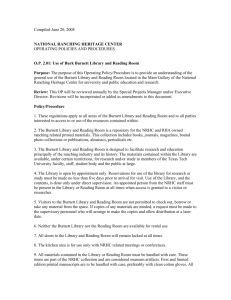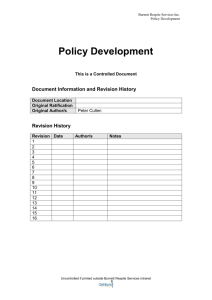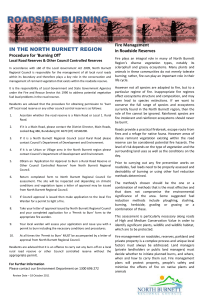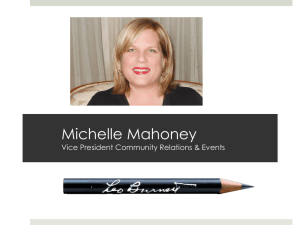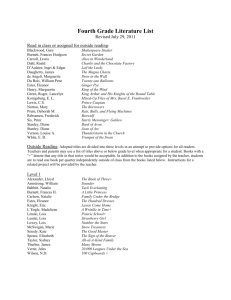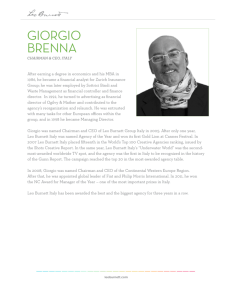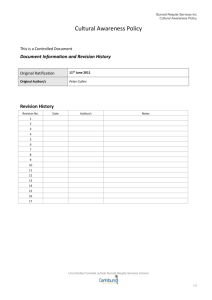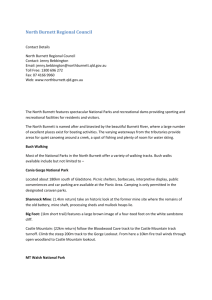THE BURNETT BANNER
advertisement
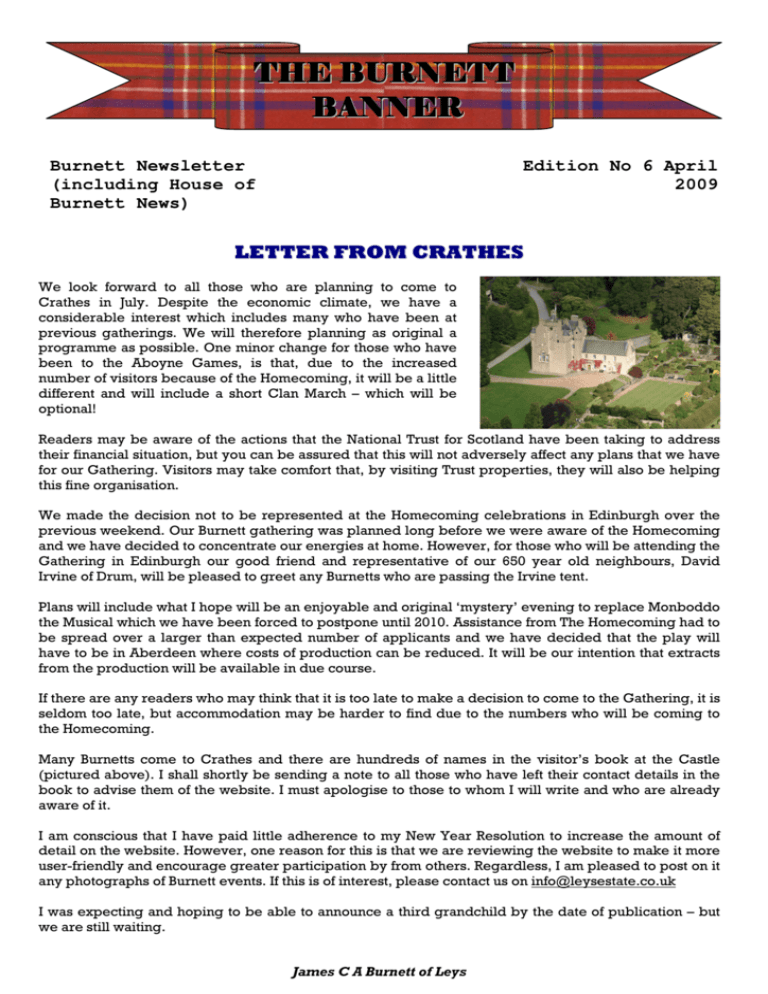
THE BURNETT BANNER Burnett Newsletter (including House of Burnett News) Edition No 6 April 2009 LETTER FROM CRATHES We look forward to all those who are planning to come to Crathes in July. Despite the economic climate, we have a considerable interest which includes many who have been at previous gatherings. We will therefore planning as original a programme as possible. One minor change for those who have been to the Aboyne Games, is that, due to the increased number of visitors because of the Homecoming, it will be a little different and will include a short Clan March – which will be optional! Readers may be aware of the actions that the National Trust for Scotland have been taking to address their financial situation, but you can be assured that this will not adversely affect any plans that we have for our Gathering. Visitors may take comfort that, by visiting Trust properties, they will also be helping this fine organisation. We made the decision not to be represented at the Homecoming celebrations in Edinburgh over the previous weekend. Our Burnett gathering was planned long before we were aware of the Homecoming and we have decided to concentrate our energies at home. However, for those who will be attending the Gathering in Edinburgh our good friend and representative of our 650 year old neighbours, David Irvine of Drum, will be pleased to greet any Burnetts who are passing the Irvine tent. Plans will include what I hope will be an enjoyable and original ‘mystery’ evening to replace Monboddo the Musical which we have been forced to postpone until 2010. Assistance from The Homecoming had to be spread over a larger than expected number of applicants and we have decided that the play will have to be in Aberdeen where costs of production can be reduced. It will be our intention that extracts from the production will be available in due course. If there are any readers who may think that it is too late to make a decision to come to the Gathering, it is seldom too late, but accommodation may be harder to find due to the numbers who will be coming to the Homecoming. Many Burnetts come to Crathes and there are hundreds of names in the visitor’s book at the Castle (pictured above). I shall shortly be sending a note to all those who have left their contact details in the book to advise them of the website. I must apologise to those to whom I will write and who are already aware of it. I am conscious that I have paid little adherence to my New Year Resolution to increase the amount of detail on the website. However, one reason for this is that we are reviewing the website to make it more user-friendly and encourage greater participation by from others. Regardless, I am pleased to post on it any photographs of Burnett events. If this is of interest, please contact us on info@leysestate.co.uk I was expecting and hoping to be able to announce a third grandchild by the date of publication – but we are still waiting. James C A Burnett of Leys PROPOSED CHANGES TO BURNETT OF LEYS WEBSITE For those who understand such esoteric subjects, I have this information from our new webmaster, Ross Stewart. We plan to rework the existing Burnett of Leys website using the Drupal platform. This platform is a Content Management System designed to move the workload of keeping a website’s content up to date from the web developer to the average computer user, allowing for more frequent content updates and additions. Drupal itself was developed to be a modular system, allowing us to freely use code created by others to provide added functionality (such as e-commerce) and to develop bespoke functionality as required. It conforms with all applicable web standards and as such is supported on every operating system and every web browser, including those for individuals with special needs. ANNETTA BURNETT COLLINS BONNER 1916 - 2008 I was very sorry to hear only recently of the death of Annetta Bonner. Annetta was one of the many members of a family who have been so strongly represented at our gatherings at Crathes, whom we have come to know so well and with whom we are always pleased to meet. Annetta, with some of her brothers and sisters was at our first gathering in 1992. Annetta was in Burgaw, North Carolina in 1916 and embarked on a successful teaching career which spanned over 40 years until 1982. Her two husbands, Edward Collins and Joseph Bonner predeceased her and she has left behind six of her seven siblings and her daughter Deborah and son Bill all of who will very much miss her. In specific to the Burnett of Leys website, the current aim is to revamp the site to provide a platform on which to begin building a community. The potential to create discussion forums and mailing lists resides within the system we’re planning to deploy, and the ability to assign users into groups and assign these groups specific permissions coupled with the site’s e-commerce abilities means that we have the ability to look into different options regarding the funding of any community built around the site. Both of these services would be maintained through a single platform, meaning minimal training would be required to get people to the point of administering the system. At first we’ll be deploying this system only locally and keeping the current site active, but the goal is to have the new site ready to go live within the next three months. For those who understand it, it will result in a more useful and user-friendly website. For those who don’t – tough! Annetta Burnett Collins Bonner with her daughter Deborah at Crathes in 1992 The Editor OBITUARIES Eva (Burnett) Jenkins passed on 7 Feb. 2009 at age 74. She was so loved by the people of Southern Indiana that the visitation went on for 10 hours and there was a steady stream of people. She worked for the Goodwill Corporation for over 40 years. She was excited about the Goodwill complex that was being built. They plan to name a part of the complex for her. We also learned of the passing of the wife of Paul Barnett. They had been married for 42 years. May it be a source of comfort at this time of sorrow that others share your loss and wish that they could comfort the families. Leland L Burnett FRIENDS OF SCOTLAND CONGRESSIONAL CAUCUS The following report and photographs were kindly provided by Judge Gilbert Burnett. On Saturday evening, January 24th, 2009, some of us Burnetts attended the Robert Burns Supper & Celebration which was sponsored by the Scottish Society of Wilmington, North Carolina, USA. This is an enjoyable annual, fun function for the Society members and guests. Our speaker was this District's Congressman Mike McIntyre. The Congressman was the leader in getting the U. S. Congress to set up and is Co-chairman of the FRIENDS OF SCOTLAND CONGRESSIONAL CAUCUS. He spoke about getting this done at our Celebration. He also was successful in getting our President Bush to proclaim April 6, 2008, as "National Tartan Day". Below is information on this and a copy of the Proclamation which Kate Fox sent to me. Kate is, as you can see, the Legislative Assistant of the Congressman. The following information is provided by Kate Fox Legislative Assistant at the Office of U.S. Congressman Mike McIntyre The Friends of Scotland Caucus was founded in 2005 in order to create a voice within Congress for Scottish-Americans, identify ways that the U.S. and Scotland can work together, and pursue the official recognition of National Tartan Day in the U.S. The Caucus has given Scottish-Americans better representation in Congress, and has brought more than 45 Members of the House and 28 Senators together in the spirit of Scottish culture, and heritage. The Caucus will co-host a Robert Burns symposium on February 24 and 25, 2009 with the Library of Congress, which will bring academics, actors, and Burns enthusiasts to Washington for a two-day event of performances, presentations, and panel discussions. The enthusiasm of the Friends of Scotland Caucus and its Members has dramatically improved U.S.Scotland relations. Last year, the Caucus hosted both the First Minister of Scotland and the Presiding Officer of Scotland in Washington, DC during their Tartan Week tour. In 2008, former President Bush also officially recognized Tartan Day as a national holiday after several years of grassroots advocacy and Congressional requests to commemorate this special day. The text of that proclamation is pasted below: Proclamation by the President: National Tartan Day, 2008 Americans of Scottis.h descent have made enduring contributions to our Nation with their hard work, faith, and values. On National Tartan Day, we celebrate the spirit and character of Scottish Americans and recognize their many contributions to our culture and our way of life. Scotland and the United States have long shared ties of family and friendship, and many of our country's most cherished customs and ideals first grew to maturity on Scotland's soil. The Declaration of Arbroath, the Scottish Declaration of Independence signed in 1320, embodied the Scots' strong dedication to liberty, and the Scots brought that tradition of freedom with them to the New World. Sons and daughters of many Scottish clans were among the first immigrants to settle in America, and their determination and optimism helped build our Nation's character. Several of our Founding Fathers were of Scottish descent, as have been many Presidents and Justices of the United States Supreme Court. Many Scottish Americans, such as Andrew Carnegie, were great philanthropists, founding and supporting numerous scientific, educational, and civic institutions. From the evocative sounds of the bagpipes to the great sport of golf, the Scots have also left an indelible mark on American culture. National Tartan Day is an opportunity to celebrate all Americans who claim Scottish ancestry, and we are especially grateful for the service in our Armed Forces of Scottish Americans who have answered the call to protect our Nation. NOW, THEREFORE, I, GEORGE W. BUSH, President of the United States of America, by virtue of the authority vested in me by the Constitution and laws of the United States, do hereby proclaim April 6, 2008, as National Tartan Day. I call upon all Americans to observe this day by celebrating the continued friendship between the people of Scotland and the United States and by recognizing the contributions of Scottish Americans to our Nation. IN WITNESS WHEREOF, I have hereunto set my hand this fourth day of April, in the year of our Lord two thousand eight, and of the Independence of the United States of America the two hundred and thirtysecond. GEORGE W. BUSH From the left on the back row, The Congressman, Vivian (Julian's wife), Stephen, then his wife, Amy, and my wife, Barbara. On the left in front are Julian Burnett and Gil Burnett One has Congressman Mike McIntyre on your left and Gilbert Burnett's son, J. Stephen Burnett, on the right. Stephen is a friend of Mike's. They attended the University of North Carolina at Chapel Hill at the same time. Photograph by courtesy of Ed Zirkle www.EdZirkle.com Judge Gilbert Burnett JOHN BURNETT CLOCKMAKER Following an enquiry from a reader who is doing some work on the Scottish clock maker John Burnett of Tarves and who dates back to the early 19th century, I unearthed the following information for which I am very grateful to Chris Edwards. Antiquarian Horologist at CHAPEL OF GARIOCH in Aberdeenshire and who writes:"John Burnett was born in 1802 and died at Gaudie Cottage, Premnay in 1891. He and his wife Agnes Shepherd of Blackstocks St Katherines are both buried in Fyvie Churchyard where there is a memorial stone. According to the Tarves Heritage Centre the Burnett family also have a ground in the churchyard at Tarves at the SW corner of the Tolquhoun tomb but there is no stone. The degree to which John Burnett actually made of the clocks with his name on, this is difficult to say. Certainly a skeleton clock I restored some years ago was NOT made by him but had his name engraved on a plaque and applied to the clock. This was fairly common for skeleton clocks which were often made in London or Birmingham. However, as far as longcase clocks are concerned the picture is less clear.In the Heritage Centre in Tarves there is a longcase clock by John Burnett. I examined this recently and while there are some parts of the movement which have individual touches (the bell hammer stop, the top of the pendulum, the fly and perhaps the pillar shape) there is no way of knowing whether the movement to a greater or lesser extent was made by the man whose name is on the dial. The painted dial and the case would have been bought in - the case would have been made by the local casemaker and the dial could have been made reasonably locally or even as far as Birmingham where the industry of painted dial manufacture started in 1772. I have heard a story of a clock maker in New Deer in the early 19th century who bought in the wheels already cut and "planted" them in the plates which he made up. This makes some degree of sense for not every clockmaker had access to or knowledge of wheel cutting. Indeed, as far as I am aware I am the only restorer in the North-East of Scotland at the present time who can cut his own wheels and therefore MAKE clocks from start to finish! How others call themselves restorers is beyond me! As far as John Burnett "specialising" in any particular clock type I can only think that he would be making/supplying what was currently fashionable. Also bearing in mind that the region was not a wealthy part of the country in the 19th century, I would imagine that predominantly he would have been making long case clocks for the local market. Spring-driven clocks are more expensive We know that in Edinburgh around 1800 a master and seven or eight apprentices were making around 12 clocks a year, John Burnett unless he was employing an apprentice or journeyman as an assistant he would not have been able to make many clocks annually. It is rare to find any clocks numbered. There was also a William Burnett, clock and watch maker, Aberchirder c. 1830, possibly sometimes at New Byth and a William Burnett, Clock and Watchmaker Fraserburgh 1846, although these two entries may refer to the same man. James C.A.Burnett of Leys BURNETT-CARGILL I was very pleased to hear from a not infrequent visitor to Crathes from Malmoe in Sweden, Michael Persson, who was interested to know of any relationship between his grandmother, a BurnettCargill, and any of the branches of the Burnett of Leys family Michael’s great grandfather was born 1871 as a Burnett-Cargill then he moved around both to Sweden and Germany and died in Australia. His grandfather was born in Sweden with a British passport and so he was Scottish at least. One thing which Eileen Bailey has unearthed is that there was a John A Burnett-Cargill whose birth was registered at the British Consulate in Hamburg between 1911 and 1915 (from the register of births by British Consuls overseas). This must be a cousin to Michael’s grandfather. There must have been at least one Burnett-Cargill family more in Hamburg at that time, since his grandfather was born some years later in Hamburg. If any reader has any information on this, Michael would be very pleased to receive it. michael_persson@msn.com James C.A.Burnett of Leys THE HOUSE OF BURNETT BURNETTS IN NEW ZEALAND A NOTE FROM THE SECRETARY Greetings; I am proud to say we will have 5 Board Members by the time this issue of the Burnett Banner is on the web-site. We also have some positive comments and several persons who are willing to do more for the House of Burnett, just short of filling an elected position. I also have others who are willing to serve on the Board, so we will be adding additional Board members soon. We must still get someone to serve as President. I have been asking and with help from the new Board Members we will get this done. I am also hopeful that the Board can come up with a way to handle dues. I will have a House of Burnett Tent at the Glasgow, Kentucky Highland Games May 29 – 31. The Chief of the Games this year is the Marques of Ailsa Lord Ailsa Kennedy, Chief of Clan Kennedy. I have been told at least 12 members of the Burnett Family will be in attendance. Since I will be going to the Gathering on 23 July I don’t how many other functions I will be able to make this year. I am still planning to make the Wisconsin Games in September. If anyone else is coming to Glasgow Games or the Wisconsin games, let me know. I’m hoping that others can go to the Games in your respective area and see that it is not as difficult as you think. I would like to start a new column in the Banner to celebrate the life of family members who pass. If you keep me informed I will pass them along for their submission to the Banner. We still have Burnett items for sale, so if there is any thing you would like check with me. I have a set of Tickets for the Gathering of the Clans programs in Edinburgh. I will be picking them up when I get there. If anyone needs tickets I will have an extra Silver Package. Leland L. Burnett Secretary House of Burnett 5982 W. Carlsville Rd. Sturgeon Bay WI. 54235 Email: burnett@dcwis.com THE EASTER BUNNY The tiny bunny, Is working all day long, Decorating Easter eggs, While humming a song, He is having so much fun, Making eggs for you and me, And small chocolate bunnies, That he gives away free, But when he is finished, He'll bring them your way, In a big coloured basket, Upon Easter day I have a letter from Allysa Carberry from Manukau in New Zealand and who would be pleased to know from which Burnett line she is descended. Her Great-Great-Grandfather was Augustus William Burnett and he married a Mary Ann Gibbons. Her Great-Grandfather was Harland John Fortesque Burnett and her Grandfather, who is still living, is Harland John Ferdinand Burnett. We have yet to establish any supportable link to her ancestors. Augustus was a not-uncommon Burnett name and there have been a number of them in the USA Whilst she does not have much information on Augustus, the details of the following generations are as follows:• Harland John Ferdinand Burnett - 5th March 1927 (Grandfather - still living) married Barbara Jean Begg • Harland Fortescue Burnett – born 1902 to 1986 (Great grandfather) married Grace Pell • Ferdinand Augustus Fortesque Burnett 1868 to Aug 1925 (Great Great grandfather) married Mary Trevelyan King • Augustus William Burnett (Great great great grandfather) married a Mary Ann Gibbons If any reader can assist, please write to me or contact Allysa Carberry directly: Allysa Carberry 48 Beaumonts Way Manurewa Manukau 2102 New Zealand T/F: 09 2670319 Email: carberrys@xtra.co.nz James C.A.Burnett of Leys BURNETT QUERIES & RESEARCH Eileen Bailey has been the official Burnett family genealogist & historical researcher. She is available to carry out specific and detailed personal Burnett research for individuals. Requests for help should be directed by e-mail to James.Burnett@leysestate.co.uk or by post to James Burnett, St Nicholas House, Station Road, Banchory. AB31 5YJ. UK. There is no charge for an initial reply to any enquiry. Estimates of cost for more detailed work can be provided and payment can be made by credit card. Editor BRIDGET BURNETT Readers will have read of the achievements of Bridget Burnett and the wonderful work that she is doing in Kenya. Herewith is an update on her activity and her most recent trip to Africa. I am grateful to her son, Mark Palumbo for keeping me informed James C.A.Burnett of Leys SECOND TRIP TO KENYA 25TH FEBRUARY 2009 I returned to Kenya in December of 2008 having raised enough donations to put a roof on the new school which they were building when I left in 2007 and to continue my work at the orphanage. Leaving Kenya and the center was very painful for me as I had grown to love all the children. They gave me a party-singing, dancing and speeches with many loving cards. Being in Kenya completely changed my life. How fortunate we are to be surrounded with so many luxuries these people could only dream of having. I was in Kenya during the presidential election in the United States. Kenya had a national holiday when Barack Obama won. I got news that my youngest grandson, Andrew Palumbo, who plays drums in his school band, was picked with his school band to go to Washington to play for President Obama’s inauguration. Now I am back in Vermont and hope to return to Kenya soon. Bridget Burnett Repairing the school roof in Kenya ARE BURNETTS HIGHLANDERS? BURNETS IN BELGIUM BURNET, BURNETT OR BURN IT Blake Burnett of Campbellford, Canada writes wondering how he would find out from of which section of the Burnett family he is a descendent. Also he wonders if the Burnett family was or was not considered as Highlanders. He noticed on the website "Sir Thomas Burnett of Leys decided that the Burnetts should be considered Highlanders." We have yet to conclude our correspondence on genealogy. However. the information is probably misleading and I am grateful to Blake Burnett for drawing this to my attention. Mr Oliver Burnet from Leglise writes to ask if those of his name with one “t” might be related to those whose name is spelt with two “t’s”. I regret that I can provide little useful information on the surname. It was Burnett for many years and a second “t” added, in our case, by the second baronet, Sir Alexander, in the 17th century. The question has been asked before and I have been unable to provide an answer. If anybody has any more theories to those which I have mentioned in the 2nd edition of this Banner (Barnet) or 4th (Pronunciation) I would be pleased to hear from them My opinion would be that the Burnetts would not be classified as Highlanders the reason being that the stronghold of the family, when they first located in the north-east was not in what was regarded as "the Highlands". The definition of a Highlander is someone who originates from the Highlands of Scotland and, of course, as we have shown the Burnards/Burnets/Burnetts were immigrants into southern England and were later given lands in the Borders of Scotland before Alexander Burnett received lands in the north-east. The Burnetts have been a prominent family in Scotland for many centuries but I think Sir Thomas was incorrect in describing them as Highlanders. Maybe he was a bit carried away but by suggesting that he considered us to be Highlanders could be argued that it is because it was also considered that we weren’t! James C. A Burnett of Leys MORE BURNETT FLORA AND FAUNA What may also be more than a coincidence is the “Burn” part of our name and Mr Burnet’s business in Belgium. Our eldest son, Alexander is very much involved in woodchip and wood pellet business at all stages. We have installed several boilers here recently and more planned. One family of close kinsmen in the US have similar wood-fuel interests on a much larger scale. Whether we have all subconsciously been attracted to wood-burning is something which I would be pleased to receive comment. I know of no arsonists although the family has had its share of fire related incidents. “They” say that when Bishop Gilbert Burnet (reverted to one “t” although his father had 2), produced his very lengthy History of His Own Times, he was loudly applauded “Burnet, Burnet”!! For those who may be interested, Oliver Burnet’s website for his business Burneco is www.burneco.com with an English translation http://translate.google.co.uk/translate?hl=en&sl=fr& u=http://www.burneco.com/&sa=X&oi=translate&res num=1&ct=result&prev=/search%3Fq%3Dburneco% 26hl%3Den I am grateful to Hollie Taylor, our assistant ranger, who was tidying out her inbox and found an email about various flora/fauna with "Burnet" in their name... For information, Alexander’s business can be viewed on www.wuidchips.com Burnet saxifrage and the genus it belongs to, commonly called Burnets (scientific name Sanguisorba) belong to the rose family. The name Burnet ris taken from the french word 'brunette' , named by a frenchman between 1225 and 1275, because of the brown hue found in the leaves. SCOLTY HILL The six spotted burnet moth, Zygaena filipendulae, and the other Burnet species (8 or 9 I think!) were named formally by Linnaeus in 1758. The use of Burnet is also a reference to their colour - they are all black/dark brown and are sometimes known as smokey moths. James C.A.Burnett of Leys One of our Gathering options is to be a guided walk up Scolty Hill close to Banchory. It is not a demanding exercise and at the summit is a memorial that was erected in 1839 to General William Burnett. The tower was restored several years ago and visitors can climb up inside it. From the hill there is a fine view of Banchory BURNETTS DOWN UNDER I have recently had some interesting correspondence with John Burnet, of Balwyn, Victoria, Australia. He had read my request on the Burnett website for information regarding Burnets or Burnetts who left Scotland to live in Australia and NZ. John can determine his family roots back to the emigration from Liverpool of James Burnet, b in 1800 in Edinburgh and his wife Grace (Robertson) who were married at St Cuthberts, Edinburgh, on 13/6/1828. James’ father was Alexander Burnet, his mother Helen/ Eleanor Millar. “Many years ago I read the novel “John Burnet of Barns”, by John Buchan, and wondered if I were possibly related to the Burnet family described in the novel. Buchan weaves a semi-factual story set in the late 17th century of the young laird of the House of Barns defending his heritage. The famous author lived for some time near Peebles, 40 km south of Edinburgh. Close by was Burnetland, the estate that arose from the marriage of John Burnet and Marion Caverhill in the early 1400’s. My great great grandfather, James Burnet, was born in Edinburgh in 1800 and married Grace Robertson at St Cuthberts, Edinburgh, in 1828. With their five children they boarded the Royal Archer at Liverpool bound for Hobart Town in the colony of Van Diemans Land in 1845. Now called Tasmania, it is an island south of the Australian mainland. In those days, the trip under sail took three or four months. Conditions were cramped in the small vessels – for most passengers two adults shared a bed 6’ x 3, in either the top or lower bunk. The trip was rough, the weather stinking hot or very cold and it was not unusual for ships to be wrecked on the Australian coast. Mrs Burnet was about six months pregnant when the voyage commenced. She knew mortality rates were high for both mother and child for births on ship. The baby was born when the Royal Archer was in the Indian Ocean. The Burnets bought land in Hobart Town and established a printing business. The land cost two hundred pounds and remained in the family for more than 100 years before being sold for thirty three thousand pounds in 1953. Hobart was established in 1804 to be used as another dumping ground for criminals from England. The first Australian settlement was a penal colony at Sydney, founded sixteen years earlier. England thereby laid claim to Terra Australis ahead of any ambitions by the French to extend their influence. The printing business prospered and some children moved to Melbourne – a much larger town that had grown rapidly following the Victorian gold rush of the 1850’s. A son established an ironmongery (hardware) business in the centre of the city, opposite the Melbourne General Post Office. Later the family moved again to Korumburra, a town just coming into being in the forests 90 kms east of Melbourne. The Burnets started the first ironmongery. The area was one of the last in Victoria to grant free land to settlers. There was a major hitch, however, with much of the area covered by eucalypts some two hundred feet tall that had to be cleared by hand. Typically a new settler would build a bark hut on his selection and after a year or so would have cleared some land. His wife and children would arrive, better housing was built with timber slabs and the kids would have to walk miles on bush tracks to the nearest school. Eventually enough land was cleared to raise cattle. My grandfather, James Burnet, met Catherine Langham and married in Korumburra in 1902. Catherine’s grandfather was a convict who had been transported to Hobart Town in 1832 at the age of twenty after stealing a man’s coat in London. Tough justice in those days! His mate actually stole the coat and Langham was an accessory to the theft. A policeman found his friend, with the coat, hiding in a ‘house of ill repute’. They were sentenced to seven years’ transportation and joined 184 other convicts in terrible confinement on the barque Lord William Bentinck 1. The vessel was 440 tons, approx 38 m (125 feet) in length and also carried soldiers, sailors, food and livestock for the voyage. The trip from Portsmouth to Hobart Town took 113 days with the barque arriving on 28 August, 1832. William Langham worked with a convict gang building roads and bridges in the country out of Hobart. For ‘being in the bushes’ with a female convict he was sentenced to seven lashes. Langham later was given a ‘ticket of leave’ and left Tasmania in the early 1840’s to settle in Victoria. His family moved east and selected heavily timbered land near Korumburra in 1877. The family prospered and became respected members of the new settlement, with William’s grandson elected the first President of the shire and a director of the local butter factory that he helped establish. One Friday afternoon in 1903 my great uncle received a telegram stating that a strike had been called by the railwaymen in Victoria and in a few days there would be no meat for the city of Melbourne. Could a mob of cattle be herded from Korumburra to Melbourne in time for next Wednesday’s market? The uncle helped bring 220 cattle together that evening ready for droving to the market 90 kms (55 miles) away. Other mobs joined the journey and by Tuesday night 1200 head of fat cattle were driven through the main streets of the city to arrive at Newmarket in time for drafting and sale the next morning. Melburnians didn’t have to become vegetarians! Members of our family now reside in Melbourne, Sydney and the Gold Coast. Whether the family is related to the Burnets of Burnetland is something that perhaps will never be known – but we will continue looking. My thanks to Lainie Campbell (nee Burnet), the genealogist for the family” John has quite a deal of information regarding our side of the Burnet family, but no information earlier than the departure from Liverpool. He wonders, given that James appeared to have money, whether he received some distribution from the sale of Burnetland, in, he believes, 1838. If any reader has any related information, John would be pleased to hear of it - johnburnet6@bigpond.com P.S. John also points out that his family are not connected to the family of Sir Macfarlane Burnet, another son of a Scottish migrant and the 1960 Nobel Laureate for Medicine and, in1960, the first to be awarded the title of Australian of the Year. BURNETT COUSINS FROM THE CROWE’S NEST I have much correspondence with Rodney Anne Anderson whose mother, Wilma Burnett Crowe, is now in her 95th year. I have much information on the family history and lumber business but of particular appeal is the annual family gathering at Christmas. The Sixty-third Annual Burnett Phoenix Christmas Tree was held at Tom Crowe’s House in Phoenix on Christmas Eve 2008. Rodney Anne has sent me a photograph of the Burnett Cousins at 1953 Christmas at the Crowe’s Nest and which I would like to include in the Banner. James C.A.Burnett of Leys THE SCOTS - BRILLIANT PEOPLE CONTINUED….. I am grateful to Sharon Volk for drawing our attention in the last Banner to the achievements of the Scots. She identified many of the most illustrious but there are some that she may have overlooked in her research Sir George Beilby (1850 - 1924) invented a manufacturing process for synthesising alkaline cyanides. Alfred Wallace (1823 - 1913), invented the Alkalimeter and a Bimetal Thermostat. Sir Joseph Thomson (1856 - 1940) discovered the electron, Ernest Rutherford, (1871 - 1937), the first to split the atom. James Sinclair (1824 - 81) made a gravitating compass and William Murdock (1754 - 1839) was prolific in his inventions from a steam tricycle, a steam cannon and a worm-driven cylinder boring machine. Sir Sandford Fleming (1827 - 1915), was the originator of Standard Time and Thomas Drummond, Limelight. Where would we be with out them? Archibald Low, (1886-1956) had so many inventions, systems for radio signalling, television, electric rocket control, coal-fuel engine, radio torpedo control gear,, vibrometer, audiometer etc., that he became president of the Institute of Patentees – a body which he doubtless monoplised. Robert Wilson made a double-acting steam hammer in 1861 and Thomas Thomson what was known as Allan’s Saccharometer although it is possible that only he knew what it was for. James Simpson, (1811-70), discovered chloroform having experimented on himself. Back row: Ric (Dickie) Brecheisen, Rodney Anne Crowe Anderson holding Gary Hirsch, John (Johnny) Brecheisen, and Mike Ray. Front row: Tom (Tommy) Crowe, Bobbie Hirsch, Linda Hirsch and Bill Ray. It is interesting to see what they are doing today: Ric has a very successful coffee business in Scottsdale, AZ, supplying coffees to area restaurants and stores, including Sam's Clubs in the southwest, employing his four children in the business. His brother John, lives in Nashville, TN, where he has a business building interiors for various chain stores. Mike Ray is retired in Paradise Valley, AZ, from his wholesale construction supply business. Tom Crowe is a successful attorney in Phoenix, currently serving on the Board of the Arizona Bar Association. Gary Hirsch works in landscaping and recently ran for the Glendale, AZ, City Council. Bobbie Hirsch O"Brien works for a company providing health benefits, while Linda currently sells fashion jewellery. Bill loved his ranch and rodeos before his death. Rodney Anne has travelled the USA with her husband's job, now retired in Jackson, TN, teaching English to Internationals, especially Japanese. John McLauchlin, a Scottish Chemist in Toronto, was responsible for Canada Dry, Maxwell Maxwell in 1850 an improved still for distilling and rectifying spirits and Thomas Horsburgh the first steel-shafted golf club. Now we’re talking. James C.A.Burnett of Leys Editor We are pleased to announce the marriage of Gary W. Burnett and Sarah N. Estrella of Harrison Arizona on the 28th of March 2009. MARRIAGE HOUSE OF BURNETT PHOTOGRAPHS Gathering of the Burnetts Relatives of Dr. JM Burnett Relatives of Dr. James K. Burnett Son and grandchildren of the Secretary of the HOB At the Wisconsin Highland Games Secretary with Chris Greisen, Quarter Back of the Georgia Force The wife of Isham R. Burnet FOR THE LOVE OF GOD, FREEDOM AND ANN “Those who do not look upon themselves as a link connecting the past with the future, in the transmission of life from their ancestors to their posterity, do not perform their duty to the world. To be faithful to ourselves, we must keep our ancestors ad posterity within reach and grasp of our thoughts and affections, living in the memory and retrospect of the past, and hoping with affection and care for those who are to come after us. We are true to ourselves only when we act with becoming pride for the blood we inherit, and which we are to transmit to others who shall fill our places.” Daniel Webster Robert Burnet was only 24 years old when he boarded the ship bound for the “new world.” As a boy, as like most boys of that time in the early 1700’s, he had been apprenticed out to learn a trade and became a tailor in Kincardine, Scotland, near Edinburgh. It was said of Robert that he was tall, nearly 6’, 2”, with black wavy hair he wore pulled back in a queue, as was the style of the day, and he had shown signs of having faint streaks of silver on his way to becoming prematurely gray. He had light blue eyes and was very handsome. He must have been good at his profession because he was able to save up not only his fare, but also booked passage for John Reid and his daughter Ann under writ of indenture. Even though he had planned to practice his profession as a tailor upon arrival in the America’s, his reason for the journey was to eventually own property and become a farmer. He had heard there was an abundance of land to be settled in the colonies, and this was his life long goal. John Reid was born and raised in Ireland and his wife, Ann’s mother, died there. It isn’t clear whether John and Robert were friends before the journey, but by the time they arrived in America, they had been known as being very close in spite of their differences in age. They settled in Raritan, New Jersey but purchased 200 acres of land in Little Britain, town of New Windsor, NY in October 1729. Robert was a very strict Presbyterian as were John and Ann, and this was, perhaps, part of the reason they became friends. Robert and Ann, however, became more than friends and Robert bargained with John that if the elder gentleman would consent to a marriage between Robert and Ann, Robert would agree to set John up with a place to live and free him from the remainder of his indenture. Naturally, John agreed and Robert married Ann in 1730, and in 1732, the first of their seven children, James, was born. They developed a true love of their new country and passed their patriotism to their children. Robert served in the French and Indian war under Capt. Ellison in 1738. His son, James served as an ensign in Capt. McClaughrey’s company of Militia in the Revolution. He eventually received half of his father’s farm where he and his wife, Mary Nicholson, raised 9 children. Robert and Ann’s second son, John Burnet, was a Major in the Revolution and sold his half of his father’s farm to his nephew (James’ eldest son, Robert R Burnet), to “remove” to the town of Phelps, Ontario Co., NY on bounty land. This was part of the Gorham/Phelps purchase that had been given by General George Washington to his soldiers in lieu of payment for their service. John was married to his best friend’s sister Gerittje (called Gertrude) VanderMark and they had four children. The Burnet’s third son, Robert Jr., also served in the Revolution, married Nancy McClaughrey and had 5 children before he died in 1790. Thomas Burnet, a Private in the Revolution, was fourth son, who was “taken with blindness” at Fort Montgomery and for such received a pension of $80 per year. He was married to Mary Johnston and fathered 7 children, but due to his disability was forced to apprentice his four youngest children to his brother and wife, John and Gertrude, to raise as their own. Son number five was Patrick who was also a Revolutionary war soldier, married Keziah Cook and fathered three. Robert and Ann’s sixth and seventh children were girls, Sarah and Mary who both were married. Eventually, Robert R. Burnet, (grandson of Robert and Ann’s, being James’ eldest) bought the entire original 200 acres of land in Little Britain. He served as a second lieutenant in the Revolution and became an Assemblyman for New York State and an original member of the Society of the Cincinnati. In 1879, there was an “Observance of the 150th Anniversary of the Establishment of the Burnet Family” on the location of the original farm, which then boasted a “spacious mansion” owned by Mr. and Mrs. Joseph B. Burnet. The gathering was attended by over 400 guests, over half of which were direct descendants of Robert and Ann. From the “minutes” of this celebration, were the following notations: “The mansion had been tastefully decorated for the occasion, and was brilliantly illuminated. The decorations included wreaths and festoons of evergreen, floral designs and foliage plants. The large hall had been put in order for dancing. At one end a stage was erected for the orchestra and the speaking, singing, and other exercises of the anniversary also took place there. Over the stage was the inscription, in evergreen letters: “150th Anniversary—Burnet—17291879.” “The mansion is a fine specimen of the old style of farm-house architecture. It was erected in 1804. Mr. Burnet [Joseph] was born in it, and in it has resided during the three score years of his life, The property now contains one hundred acres, Mr. Burnet has in his possession the original deed of the farm, dated October 7, 1729. Among the family portraits hanging on the wall is that of Robert Burnet, grandfather of the present occupant.” Revered historian, one Mr. E. M. Ruttenbur, was the guest speaker that evening and in his address to the company which is, in fact, several pages long, I wish to quote just a couple of poignant lines. “We have assembled this evening for a very laudable purpose--that of honoring the progenitor of one of the oldest and most respectable families of the neighborhood and town, I refer to Robert Burnet and his wife, Ann Reid, who, a century and a half ago, lighted here a fire upon their family hearthstone that has not been extinguished in the changes of the passing years. It is quite reasonable to presume that among those present there are none who regard this assemblage as improper—none who are prepared to deny the force of the Divine Injunction, “honor thy father and thy mother…” let the influence of the good examples of your fathers be known; let the world see why it is you are what you are.” Mr. Ruttenbur closed his oration with the following: “Through letters and wills and deeds and public services and charities we may sill look at them in living records until they almost seem to hold communion with us and show us what manner of [people] they were. It is regretted that we know so little about them as we do when even the full sum of our knowledge is told. Did we know more we might be more true to ourselves in acting as Webster suggests, “with becoming pride for the blood we inherit,” and with more carefulness for its untarnished transmission, “to those who shall fill our places.” Aye, indeed, Mr. Ruttenbur, I pray that his feeble attempt to put to pen and thus honor these two people, I can somehow preserve the legacy they left behind. My grandfather, Bennett Willis Burnett, was descended from the family of Thomas Burnet, Robert and Ann’s fourth son, and among those four who were raised by John and Gertrude Burnet. I indeed, have “become pride for the blood we inherit.” Phyllis Esler is the owner, manager of Thistle House Bed & Breakfast in Granite Falls, NC. One of the rooms in the house is called the “House of Burnett” (see below) after the Scotland connection here described. "A TASTE OF SCOTLAND" Presenting your opportunity & invitation to participate in North Carolina's most exciting 13th Annual Scottish Street Festival, June 20, 2009, (always Fathers Day Weekend) in downtown Franklin, NC. This year's honored Clan: Clan MacGregor Hosting organization: 'The Friends of The Scottish Tartans Museum” Bishop John C. Grand Chaplain of Clan Grant and former Honored Clan of The Taste of Scotland says, "This is your personal invitation and opportunity to represent your Clan and acquire new members, share Clan history and information with the thousands of visitors, folks from Franklin, from all over the State and around the Nation!! The entertainment and excitement are amazing! This is something you will never regret or forget!" For further information contact: Gail Walters,88 Skip Walters Road, Franklin,NC USA H: 828-369-9570 M: 828 342 9245 Email lilagirl40@aol.com THE DINNIE STONES For those who intend to visit Crathes in July, some may wish to attempt a feat which may be unaccomplished by many. At the Potarch Inn, 5 miles west of Banchory beside the River Dee are the Dinnie Stones. The stones weighing a total of 785lbs. were carried by Donald Dinnie in 1860. Here is his description of them from his book written in 1912. "On the granite stone bridge that crosses the River Dee at Potarch there were, and still are, two large stones weighing about 8cwt the pair, placed in a recess. In the early 1830's massive iron rings were placed in them, to which ropes were fixed so that scaffolds could be attached for pointing the bridge. Now, one of these stones was somewhat heavier than the other. Very few strong men of that day could lift the heavy one with both hands, but my father could raise one in each hand with apparent ease, and could throw the heavier stone of the two on to the top of a parapet wall of the bridge. Those stones are still on the bridge and I myself lifted one in each hand on many occasions and one market day, I carried them across the bridge and back, some four to five yards." For those who wish to know a little more, please refer to www.gordondinnie.com I take no responsibility from any injury incurred in an attempt to move them. The owner of the Potarch welcomes anyone who wishes to try. Phyllis Esler James C.A.Burnett of Leys RECIPES HOT CROSS BUNS (By Delia Smith) It's hard to believe the difference in home-made hot cross buns – they really are far better than any bought from a shop and a lot cheaper into the bargain! But easy-blend dried yeast is not suitable for this recipe. If you want to make more distinctive crosses, use a flourand-water paste made with 4 oz (110 g) plain flour and approximately 3 tablespoons water. Roll out thinly and divide into small strips, dampening them to seal. Ingredients: 2 oz (50 g) caster sugar, plus 1 level teaspoon 1 level tablespoon dried yeast 1 lb (450 g) plain flour 1 level teaspoon salt 1 rounded teaspoon mixed spice 3 oz (75 g) currants 2 oz (50 g) cut mixed peel 1½-2 fl oz (40-55 ml) warmed milk 1 egg, beaten 2 oz (50 g) butter, melted For the glaze: 2 level tablespoons granulated sugar JOHN ABE BURNETTE FAMILY POUND CAKE (Suzanne Basham Princiotta) You will need a Bundt pan, large mixing bowl and wooden spoon or mixer - DO NOT preheat oven Ingredients: Add one at a time in this order: 2 sticks unsalted Butter - softened to room temperature ½ cup Crisco all vegetable shortening Cream together and continue adding in order: 3 cups Sugar (½ cup at a time) 5 large Eggs (one at a time, beat well) 3 cups Flour (all purpose – do not use self rising, ½ cup at a time) ¼ tsp. ec. Salt and Baking powder 1 cup Milk (regular or 2 %) 1 tsp. Vanilla extract 1 tsp. Lemon extract (depending on your taste, I use 2 tsps.) You will also need a greased baking sheet First stir the teaspoon of caster sugar into 5 fl oz (150 ml) hand-hot water, then sprinkle in the dried yeast and leave it until a good frothy 'beer' head forms. Meanwhile sift the flour, salt and mixed spice into a mixing bowl and add the remaining 2 oz (50 g) of sugar, the currants and mixed peel. Then make a well in the centre, pour in the yeast mixture plus 1½ fl oz (40 ml) of milk (again hand-hot), the beaten egg and the melted butter. Now mix it to a dough, starting with a wooden spoon and finishing with your hands (add a spot more milk if it needs it). I use one of my decorative bundt pans well greased and floured (Baker’s spray is good too). Cook in cold oven at 350 degrees for 1 ½ hrs. (ovens will vary -- I start checking 15 minutes early with toothpick deep in the center). Your top will be real crusty – makes a good bottom. You can drizzle with a light lemon, chocolate or your favorite flavor glaze. This is a very dense, rich pound cake so don’t overdo it. I like best plain with fresh fruit and/or good vanilla bean ice cream. ******** Then transfer the dough on to a clean surface and knead it until it feels smooth and elastic – about 6 minutes. Now pop it back into the bowl, cover the bowl with a lightly oiled plastic bag, and leave it in a warm place to rise – it will take about an hour to double its original size. Then turn it out and knead it again, back down to its original size. Divide the mixture into 12 round portions, arrange them on the greased baking sheet (allowing plenty of room for expansion), and make a deep cross on each one with a sharp knife. Leave them to rise once more, covering again with the oiled polythene bag, for about 25 minutes. Meanwhile pre-heat the oven to gas mark 7, 425°F (220°C). Bake the buns for about 15 minutes. Then, while they're cooking, melt the sugar and 2 tablespoons of water for the glaze over a gentle heat and brush the buns with it as soon as they come out of the oven, to make them nice and sticky Hot cross buns

